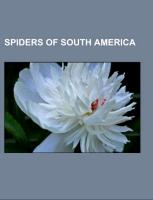- Start
- Spiders of South America
Spiders of South America
Angebote / Angebote:
Source: Wikipedia. Pages: 54. Chapters: Acanthoctenus, Acanthopelma, Acanthoscurria brocklehursti, Acragas (spider), Actinopus, Admesturius, Agelista, Aillutticus, Albionella, Alcmena (spider), Amatorculus, Ami (genus), Amphidraus, Amycus (spider), Anaurus (spider), Ancylometes, Anokopsis, Aphantochilus, Aphirape, Aphonopelma seemanni, Arachnomura, Arachnotermes, Araneus cinnabarinus, Argiope argentata, Arnoliseus, Asaphobelis, Asaracus, Ashtabula (spider), Atelurius, Atomosphyrus, Austrochilidae, Avicularia, Avicularia bicegoi, Avicularia metallica, Avicularia urticans, Avitus (spider), Balmaceda (spider), Banksetosa, Beata (spider), Belliena, Bertrana, Brachypelma, Brazilian red and white tarantula, Brazilian wandering spider, Brazilian whiteknee tarantula, Breda (spider), Bryantella, Bucranium taurifrons, Cheiracanthium inclusum, Chilean recluse spider, Darwinneon, Descanso (spider), Diagondas, Diplura (spider), Donaldius, Envia garciai, Erica eugenia, Eupalaestrus campestratus, Goeldia, Goliath birdeater, Grammostola, Grammostola actaeon, Grammostola pulchra, Grammostola pulchripes, Greenbottle blue tarantula, Helvetia semialba, Hibana, Kukulcania, Lapsias lorax, Latrodectus antheratus, Losdolobus, Lygromma, Lygromma anops, Megaphobema robustum, Melychiopharis, Melychiopharis cynips, Microstigmatidae, Misionella, Misumenoides, Misumenops, Myrmecium (spider), Mysmenopsis, Nephila clavipes, Nephilengys cruentata, Notnops, Oarces, Oarces reticulatus, Pamphobeteus, Paracenobiopelma, Paratropididae, Patu digua, Peucetia viridans, Phormictopus cancerides, Pinktoe tarantula, Plesiolena, Psalmopoeus, Psellocoptus, Skeleton tarantula, Tenedos (spider), Theraphosa, Venezuelan suntiger, Zygoballus lineatus. Excerpt: Phoneutria, commonly known as Brazilian wandering spiders, armed spiders ("armadeiras", as they are known in Portuguese), or banana spiders (not to be confused with the relatively harmless Nephila), are a genus of defensive and venomous spiders of potential medical significance to humans. They are mainly found in tropical South America, with one species in Central America. These spiders are members of the Ctenidae family of wandering spiders. The Brazilian wandering spiders appear in Guinness World Records from 2010 as the world's most venomous spider. Guinness World Records states that although the Brazilian wandering spider is the most toxic, an effective antivenom is available and few fatalities occur. The genus Phoneutria (Greek for "Murderess") contains eight scientifically described species, the most notorious being P. fera and P. nigriventer. The spiders in the genus can grow to have a leg span of 13 to 15 cm (5.1 to 5.9 in). Their body length ranges from 17 to 48 mm (0.67 to 1.9 in). While some other araneomorph spiders have a longer leg span, the largest Phoneutria species have the longest body and the greatest body weight in this group. The genus is distinguished from other related genera such as Ctenus by the presence of dense prolateral scopulae (a dense brush of fine hairs) on the pedipalp tibiae and tarsi in both sexes. Phoneutria are easily confused with several other non-medically significant ctenids, especially Cupiennius, in which the recently described C. chiapanensis also has bright red hairs on the chelicerae. Additionally, some Phoneutria species lack red hairs on the chelicerae, making it an unreliable identification feature. The presence of a dark linear stripe or stripes on the frontal (dorsal) palps and pr...
Folgt in ca. 5 Arbeitstagen
